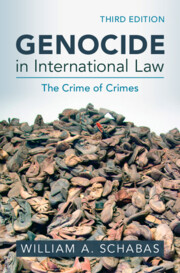2520 results
Introduction
-
- Book:
- The Individual in the Law and Practice of the International Court of Justice
- Published online:
- 25 March 2025
- Print publication:
- 30 April 2025, pp 1-12
-
- Chapter
- Export citation
8 - Environmental Disputes
- from Part II - The Individual in the Practice of the International Court of Justice
-
- Book:
- The Individual in the Law and Practice of the International Court of Justice
- Published online:
- 25 March 2025
- Print publication:
- 30 April 2025, pp 197-227
-
- Chapter
- Export citation
53 - Global and National Constitutionalism
- from Part III E - The Global System
-
-
- Book:
- The Cambridge Handbook of Constitutional Theory
- Published online:
- 27 March 2025
- Print publication:
- 24 April 2025, pp 938-954
-
- Chapter
- Export citation
55 - International Organisations
- from Part III E - The Global System
-
-
- Book:
- The Cambridge Handbook of Constitutional Theory
- Published online:
- 27 March 2025
- Print publication:
- 24 April 2025, pp 974-994
-
- Chapter
- Export citation
50 - Bills of Rights
- from Part III D - The Legal System
-
-
- Book:
- The Cambridge Handbook of Constitutional Theory
- Published online:
- 27 March 2025
- Print publication:
- 24 April 2025, pp 884-901
-
- Chapter
- Export citation
3 - Legal Frameworks
- from Part II - Legal Controls
-
- Book:
- Combatting the Code
- Published online:
- 26 March 2025
- Print publication:
- 03 April 2025, pp 37-46
-
- Chapter
- Export citation
Introduction
-
- Book:
- Genocide in International Law
- Published online:
- 14 March 2025
- Print publication:
- 03 April 2025, pp 1-13
-
- Chapter
- Export citation
The plural professional: How UN human rights experts construct their independence
-
- Journal:
- Review of International Studies , First View
- Published online by Cambridge University Press:
- 28 March 2025, pp. 1-21
-
- Article
-
- You have access
- Open access
- HTML
- Export citation
Call Me By Your Name: The Impacts of American Human Rights Violations in Authoritarian States
-
- Journal:
- British Journal of Political Science / Volume 55 / 2025
- Published online by Cambridge University Press:
- 28 March 2025, e51
-
- Article
-
- You have access
- Open access
- HTML
- Export citation
Reflections on Progress and Shaping the Future of Maternal and Child Health in Global Health Law
-
- Journal:
- Journal of Law, Medicine & Ethics ,
- Published online by Cambridge University Press:
- 27 March 2025, pp. 1-2
-
- Article
- Export citation
Vaccine Inequity in the COVID-19 Crisis: Lessons to Leverage Global Health Law through Market-Shaping Policies
-
- Journal:
- Journal of Law, Medicine & Ethics ,
- Published online by Cambridge University Press:
- 27 March 2025, pp. 1-4
-
- Article
-
- You have access
- Open access
- HTML
- Export citation
Global Health “With Justice”: The Challenges and Opportunities for Human Rights in Global Health Law
-
- Journal:
- Journal of Law, Medicine & Ethics ,
- Published online by Cambridge University Press:
- 27 March 2025, pp. 1-5
-
- Article
-
- You have access
- Open access
- HTML
- Export citation

Combatting the Code
- Regulating Automated Government Decision-Making in Comparative Context
-
- Published online:
- 26 March 2025
- Print publication:
- 03 April 2025
Long-term segregation and seclusion for people with an intellectual disability and/or autism in hospitals: critique of the current state of affairs: commentary, Quinn et al
-
- Journal:
- The British Journal of Psychiatry , FirstView
- Published online by Cambridge University Press:
- 24 March 2025, pp. 1-3
-
- Article
- Export citation
Freedom is (still today) therapeutic: centenary and continuing relevance of Franco Basaglia
-
- Journal:
- The British Journal of Psychiatry , FirstView
- Published online by Cambridge University Press:
- 19 March 2025, pp. 1-3
-
- Article
-
- You have access
- HTML
- Export citation
Reporting of oral chemical restraint in the Mental Health Services Monthly Statistics for England
-
- Journal:
- BJPsych Bulletin , FirstView
- Published online by Cambridge University Press:
- 17 March 2025, pp. 1-5
-
- Article
-
- You have access
- Open access
- HTML
- Export citation

Genocide in International Law
- The Crime of Crimes
-
- Published online:
- 14 March 2025
- Print publication:
- 03 April 2025
Rethinking Japan's Constitution from the Perspective of the Ainu and Ryūkyū Peoples
-
- Journal:
- Asia-Pacific Journal / Volume 16 / Issue 5 / March 2018
- Published online by Cambridge University Press:
- 14 March 2025, e5
-
- Article
- Export citation
The Constitution, Human Rights and Pluralism in Japan: Alternative Visions of Constitutions Past and Future
-
- Journal:
- Asia-Pacific Journal / Volume 16 / Issue 5 / March 2018
- Published online by Cambridge University Press:
- 14 March 2025, e1
-
- Article
- Export citation
Human Rights ‘Fact’ Production and Why It Matters: Myanmar as a Case in Point
-
- Journal:
- Asia-Pacific Journal / Volume 20 / Issue 18 / October 2022
- Published online by Cambridge University Press:
- 14 March 2025, e6
-
- Article
- Export citation


